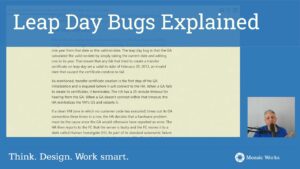“Once you stop learning, you start dying” Albert Einstein.
I am a new member of Mozaic Works team and I am involved in marketing actions within the company. I learn new things and improve continuously my knowledge to face the day-to-day challenges. Learning is a continuous process and we can learn from anybody. My daughter teaches me nowadays how to be curious and to ask many questions. Several days ago a colleague told me I am fit for the Product Owner role. This made me wonder: who invented this role and why? What does it involve? How can I learn more about it?
Here’s what I learned from Proceedings of the 41st Hawaii International Conference on System Sciences – 2008:
“The need for this role arose from the “software crisis” of 1969, an unacceptable failure rate in software development projects. In R. Charette’s 2005 IEEE Spectrum article, “Why Software Fails”, eight of the twelve most common factors for project failure lie the relationship of the businesses to development: unrealistic or unarticulated project goals, poor reporting of the project’s status, unmanaged risks, poor communication among customers, developers, and users, poor project management, stakeholder politics, and commercial pressures.
Agile attempts to resolve the “software crisis” by, “satisfy(ing) the customer through early and continuous delivery of valuable software.” It addresses the challenge of aligning development to business value by insisting “business people and developers must work together daily throughout the project.” (Beck, K., Beedle, M., et, al.,. Principles Behind the Agile Manifesto. ) Scrum elaborates on this by insisting the business be represented by one accountable, empowered individual – Product Owner.”
So the Product Owner (PO for short) would be the bridge between business and developers. Sounds like an important role for the success of a software project.
What is a product owner supposed to do? I learned a PO should:
- Define and maintain the product vision
- Identify features desirable for users
- Help the team define and coordinate the release
- Iteratively clarify the requirements so that the ones with the highest business value are ready for development. This process is called backlog grooming.
- Help the team plan the iteration by providing the user stories, acceptance criteria and any clarification necessary. This typically happens during the sprint planning meeting that the PO should attend.
It sounds like an interesting and challenging role, different from software development but equally important in a team. It also sounds like I need to learn much more about it before being proficient in such a role.
Are you a Product Owner or want to become one? Are you trying to recruit POs for your organization? What challenges do you face? Let us know in the comments!
If you want to continue the learning process, we can help with:
- An assessment on your organizational practices
- Learn about the PO role at the CSPO training with Xavier Quesada Allue
- Learn about the PO role at the “Product Owner” workshop with Oana Juncu
- Learn more about managing products and teams at the Management 3.0 workshop
Want to learn something else? Let me know and we will create a customized package for your needs.










